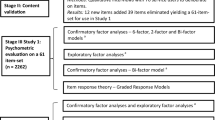Abstract
Quality of life measurement has historically been characterized by a focus on physical functionality, great variability in definitions and insufficient attention to psychometric properties of measures. The present study examined four core subscales of the Quality of Life Enjoyment Scale (Q-LES-Q) designed to assess subjective quality of life (i.e. physical health, subjective feelings, leisure activities and social relationships) administered to 151 male and female subjects with severe mental illness admitted to a residential community treatment center or a university psychiatric hospital. The use of factor analysis is a common approach to examining construct validity of instruments through the examination of correlated clusters of item responses. Those sets of highly correlated item responses should identify a construct or dimension of related items (i.e. a factor). Two factor approaches, exploratory (i.e. the maximum number of possible factors is unspecified) and restricted (i.e. the maximum number of factors allowed is specified), were employed to examine construct validity of the four Q-LES-Q subscales. In addition, both orthogonal (i.e. independence between factors is maximized) and oblique (i.e. correlated factors are allowed) rotations (arrangements) of factor structure were also investigated to define subscale validity further. Results supported good construct validity for each subscale with either factor approach, i.e. the four proposed subscales were clearly identifiable in the factors (groupings) of correlated item responses from the sample. In both cases, the orthogonal (independent) rotation produced the simplest structure, i.e. the clearest groupings of items. These results indicate that the Q-LES-Q does appear to measure valid dimensions matching those proposed by the subscales and, thus, may be a useful and reliable tool for clinical applications.
Similar content being viewed by others
References
Katz S. The science of quality of life. J Chronic Dis 1987; 40(6): 459–463.
Sullivan G, Wells KB, Leake B. Clinical factors associated with better quality of life in a seriously mentally ill population. Hospital Commun Psychiatr 1992; 43(8): 794–798.
Awad AG. Quality of life of schizophrenic patients on medications and implications for new drug trials. Hospital Commun Psychiatr 1992; 43(3): 262–265.
Tantam D. Quality of life and the chronically mentally ill. Int J Soc Psychiatr 1988; 34(4): 243–247.
Lehman AF, Ward NC, Linn L. Chronic mental patients: the quality of life issue. Am J Psychiatr 1982; 139(10): 1271–1276.
Ganz PA. Quality of life measures in cancer chemotherapy. Pharmacoeconomics 1994; 5(5): 376–388.
Spitzer WO. State of science 1986: quality of life and functional status as target variables for research. J Chronic Dis 1987; 40(6): 465–471.
Tait R, Duckro P, Margolis R, Wiener R. Quality of life following the treatment: a preliminary study of in-and outpatients with chronic pain. Int J of Psychiatr Med 1988; 18(3): 21–283.
Meltzer H. New drugs for the treatment of schizophrenia. Psychiatr Clin N Am 1993; 16: 365–385.
Bigelow D, McFarland B, Olson M. Quality of life of community mental health program clients: validating a measure. Comm Mental Health J 1991; 27: 43–55.
Heinrichs DW, Hanlon TE, Carpenter WT. The Quality of Life Scale: an instrument of rating the schizophrenic deficit syndrome. Schizophrenia Bull 1984; 10(3): 388–398.
Becker M, Diamond R, Sainfort F. A new patient focused index for measuring quality of life in persons with severe and persistent mental illness. Qual Life Res 1993; 2: 239–251.
Endicott J, Nee J, Harrison W, Blumenthal R. Quality of Life Enjoyment and Satisfaction Questionnaire: a new measure. Psychopharmacol Bull 1993; 29(2): 321–326.
Lehman AF, Burns BJ. Severe mental illness in the community. In: Spilker B, ed. Quality of Life Assessments in Clinical Trials. New York: Raven Press Ltd, 1990: 357–366.
Jaeschke R, Guyatt GH. How to develop and validate a new quality of life instrument. In: Spilker B, ed. Quality of Life Assessments in Clinical Trials. New York: Raven Press Ltd, 1990: 47–57.
Schipper H, Clinch J, Powell V. Definitions and conceptual issues. In: Spilker B, ed. Quality of Life Assessments in Clinical Trials. New York: Raven Press Ltd, 1990: 11–23.
Lehman AF. Aquality of life interview for the chronically mentally ill. Eval Program Plan 1988; 11: 51–62.
Pedhazur EJ, Pedhazur Schmelkin L. Measurement, Design and Analysis: an Integrated Approach. New Jersey: Lawrence Erlbaum Associates, 1991.
Norman GR, Streiner DL. Biostatistics: The Bare Essentials. Toronto: Mosby, 1994. pp. 131.
Kline P. An Easy Guide to Factor Analysis. Routledge: London, New York, 1994.
Author information
Authors and Affiliations
Rights and permissions
About this article
Cite this article
Bishop, S.L., Walling, D.P., Dott, S.G. et al. Refining quality of life: validating a multidimensional factor measure in the severe mentally ill. Qual Life Res 8, 151–160 (1999). https://doi.org/10.1023/A:1026489331009
Issue Date:
DOI: https://doi.org/10.1023/A:1026489331009



